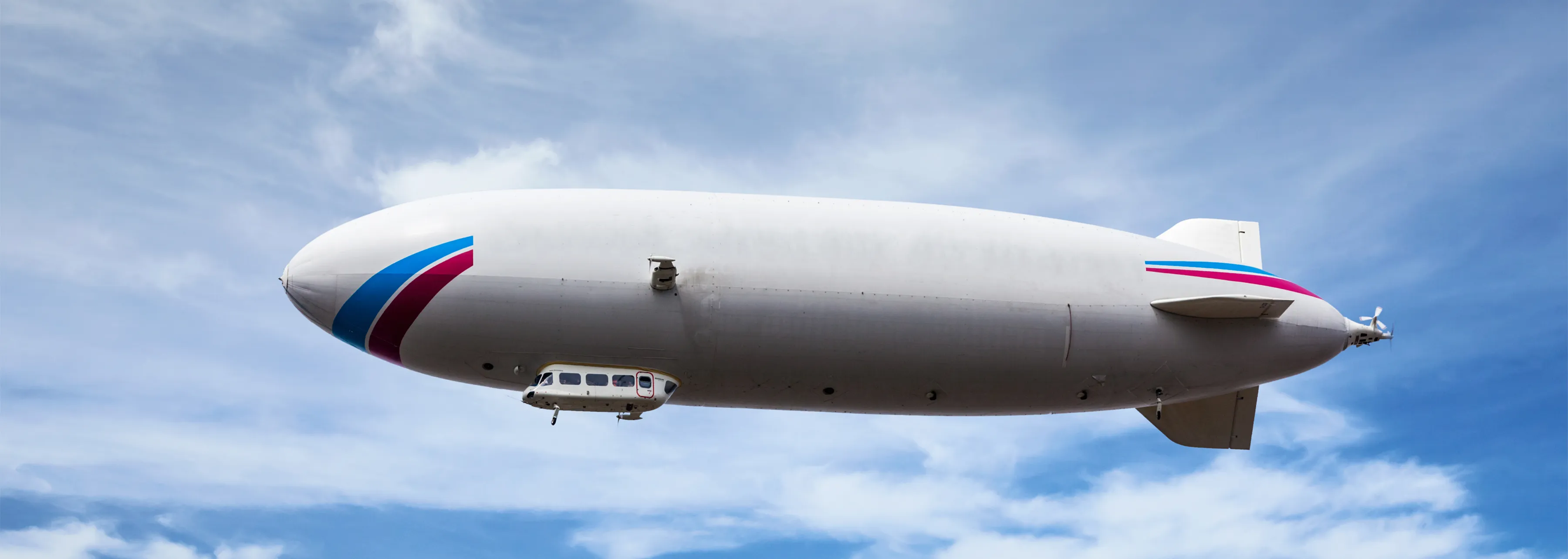What comes to mind when you think of an airship? For many, it's the Goodyear blimp or the Zeppelins of the 20th century. There are many different kinds of airship, each with a range of uses — but what aircraft actually count as airships? The term 'airship' refers to buoyant aircraft, given their lift by lighter-than-air gas such as helium or hydrogen. Some airships get only part of their lift from gas, with the rest coming from aerodynamics and vectored thrust: these airships are known as 'hybrid'.
Airships might not be a common sight in the 2020s, but there are many people of the belief that they will soon be making a comeback — particularly in the logistics industry, transporting cargo. In fact, CNN reported that independent estimates put the value of the airship market at $50bn over the next 20 years. Should we be preparing ourselves for soon-to-be regular airship sightings?
Airships: an overview

Airships have been used historically for intelligence, moving military cargo, passenger transport, exploration, and more recently, for commercial purposes such as advertising.
Airships aren't pressurised like aeroplanes, so they can't fly much higher than 10,000 feet. The maximum speed of an airship really depends on the ship; Goodyear states their top speed as 73mph (~117.5 km/h), but some companies developing cargo airships claim top speeds of over 90mph (150km/h).
There are different kinds of airships, each of which operates differently and thus their functionality varies. Airships exist on a spectrum of non-rigid–rigid, depending on their level of structure.
Blimps
A blimp may be what most people think of when they picture an airship, but they are really only one kind. A blimp is a non-rigid airship, meaning it has no internal structure. They are ultimately balloons, with a gondola and motors attached, and they rely on internal gas pressure to maintain their shape.
This pressure, however, means that blimps can only be so large before there is too much tension for the material of the balloon. This means that they cannot carry as much weight as other airships, which, if you're thinking about transporting cargo, is a serious downside.
Prior to 2011, Goodyear employed blimps for their aircraft, used for advertising and capturing aerial footage of live television events. Goodyear aircraft do also carry passengers on an invite-only basis, so passengers are limited to guests of the company or members of the press.
Semi-rigid airships
Like a blimp, semi-rigid airships are pressurised, but they also have some internal structure to maintain their shape. This means that they can be larger than blimps and are therefore less limited in terms of cargo weight. Many Goodyear airships are semi-rigid, such as the Wingfoot One, Two, and Three.

Their internal structure adds some mass that has to be compensated for with lifting gas — however, given that these airships only have some structure, the extra weight is not as much for these ships as it is for rigid airships.
Rigid airships
Many people are familiar with Zeppelins — these are actually a kind of rigid airship. Rigid airships use internal supports to keep their shape, not at all relying on internal gas pressure. They can withstand more mass than blimps, as they are structurally reinforced and can be much larger.
Given that the structures of rigid airships are more structured than any other kind of airship, there is much more weight that must be compensated for with lifting gas. This means that the smallest viable rigid airship is still larger than that of a blimp. However, these structures also mean that rigid airships don't face the same sizing limits as blimps — if you want to scale up the ship, you can just scale up the internal support; there is no risk of too much tension.
Are airships safe?

The first thing that comes to many people's minds when they think of airships is the Hindenburg disaster. The Hindenburg was a passenger-carrying rigid airship which caught fire and was ultimately destroyed during a flight in 1937. 35 of the 97 people on board were killed. It's thought that the disaster was caused by a spark igniting leaked hydrogen, a very flammable gas.
Many have concluded that hydrogen is unsafe due to its flammability, and following the Hindenburg disaster, hydrogen was banned as a lifting gas by several aviation bodies. Hydrogen is allowed for unmanned ballooning, however, and at Sent Into Space, we have a great deal of experience with safely using hydrogen as a lift gas for high-altitude balloon launches.
The use of hydrogen may have contributed to the Hindenburg disaster, but another significant factor was likely poor engineering and design decisions in its construction. The Hindenburg was painted with a highly flammable celluloid coating, and had no means to mitigate the build-up of static electricity which could have caused the initial spark.
Aeroplanes used to be incredibly dangerous until we were able to engineer them safely — in the same way, even airships lifted by hydrogen will likely be safe when properly constructed and when the right precautions are in place. Similarly, while it might be the most well-known, the Hindenburg is not the only airship that's led to disaster. The US Navy's USS Akron crashed in the 1930s, with only 3 survivors; 73 people were killed, a much higher rate of fatality than the Hindenburg. Most significantly, the USS Akron didn't use hydrogen — it was helium filled. With this in mind, it’s clear that hydrogen gas is not solely to blame for the airship accidents of the past.
Why don't airships fly anymore?
While airships are still used, they aren't exactly commonplace today. Airships are big, and you need a lot of space to build and maintain them. That alone is a big expense — add it to the cost of actually building and running a ship, and it's a fairly costly exercise.

Airships are much slower than planes, so they are generally not very useful for passenger transport, especially on a larger scale. They do have other potential uses though; notably in logistics.
Airships and cargo transport
While airships are not necessarily great for passenger transport, there are many reasons why they could be the next big thing in moving cargo. Today, international cargo transit is largely completed using aeroplanes and ships. Aeroplanes are fast, but expensive, and they're bad for the environment. Cargo ships are inexpensive but slow, and despite their reduced speed, they still have a big carbon footprint.

There are an increasing number of people who believe that airships could fill the gap between ships and aeroplanes, being uniquely fast enough and cheap enough, while also having a much lower environmental impact.
Speed and cost efficiency of cargo transportation
Cost efficiency is generally the most influential factor in any industry; in logistics, whatever can transport something in the quickest time for the least amount of money is the most appealing option. Cargo ships are slow but cheap, aeroplanes are fast but expensive — this is where airships come in. Travelling at over 100km/h, with some boasting speeds of 150km/h, they are much faster than cargo ships. While they may be slower than aeroplanes, they're much cheaper, making them an incredibly cost-effective method of cargo transport.
A 2020 article on the economic feasibility of airships by an academic at the Moscow Aviation Institute states that "the cost of transportation by airship is approximately the same as the cost of transportation by the sea, and it is much lower than by plane". Being able to transport cargo for the same cost as at sea, but much faster, sounds like a no-brainer. However, the article also states that smaller airships are considerably less cost-effective than larger ones, so size would certainly be something to take into consideration when it comes to introducing airships to logistics.
Infrastructure requirements for airships
In order to reach an area by ship, you need a port; for access via aeroplane, you need an airport. Trains need rail lines, and trucks need roads. The reliance on this infrastructure can be a huge limitation in transporting cargo, as it only provides access to areas that already have the appropriate infrastructure in place, or which have the capabilities to build this infrastructure.
Airships, however, don't need this same infrastructure. They need enough space to land, but they can land on most unprepared surfaces, which means you don't need specialist landing areas. This means that they can reach areas that would be otherwise inaccessible by road, air, water, or rail.
This increased access also means that airships could be valuable in providing aid to otherwise unreachable areas. This would be especially useful following a natural disaster, where airports, roads, and railways may have been destroyed or damaged.
The environmental impact of airships
As climate change becomes an ever greater issue, many people and businesses are looking for ways to reduce their carbon footprint. Airships seem to have some real potential in this area, given that they rely mostly on lighter-than-air gas rather than fuel, making them greener than both aeroplanes and ships.

Airship manufacturer Hybrid Air Vehicles (HAV), which hopes to ferry passengers on short-haul routes with their Airlander airships, states that their planned route from Barcelona to Palma de Mallorca would produce a 4.5kg carbon footprint per passenger, compared to 53kg on an aeroplane. HAV claims that switching these sorts of flights from planes to airships would reduce carbon emissions by 90%.
Unmanned airships
Some of the airships currently in development are fully autonomous, and so unmanned. Unmanned airships are cheaper, as not having any people on board means that flights can have longer durations, there are no crew quarters or provisions required, and there is also a reduced cost of labour.
Safety is a huge benefit of unmanned airships. Pilot error is thought to be the most common cause of aviation accidents, so an airship with the least room for human error is likely the safest. Similarly, even in the case of an accident, having no one on board means that there are no crew members at risk of being injured.
However, there is a potentially negative aspect of operating unmanned airships. There are many people working in the logistics industry — along with every other industry — whose jobs could be at risk with the increase of automation. However, even huge cargo ships such as container ships do not have large crews. Airships need maintenance, and even automated systems need real people monitoring them — and people would still be needed for loading cargo. As such, it is likely that even unmanned airships will create an abundance of jobs in running properly and efficiently.
Who is making airships?

There are several companies currently developing airships for a range of uses. While none of these have taken to the sky yet, there is hope that multiple manufacturers will have completed test flights by 2030.
Aerosmena
Aerosmena is a Russian airship manufacturer currently developing a cargo airship with a potential 600-tonne capacity. They claim that the ship will deliver cargo to communities in remote regions including mountains, islands, and deserts which lack infrastructure. The manufacturer was initially aiming to launch the ship in 2024, but this date has been pushed back due to a combination of factors, likely including COVID-19 and the outbreak of war in Ukraine.
Atlas
Atlas is currently developing airships to be used for leisure and passenger transport, communications and intelligence, and for cargo transit. Atlas' ATLANT cargo airships are unmanned, rigid-body hybrid airships that could carry up to 165,000kg of cargo with a cruise speed of 120km/h. With the ability to land on hard runways, soil, water, ice, snow, wetlands, and sand, the capabilities of the ATLANT airships are impressive.
Flying Whales
Flying Whales are developing the LCA60T airship, a rigid cargo airship. With the ability to travel at 100km/h with a 60 tonne payload, the LCA60T is one to watch. The ship's first flight is planned for before 2026, which, if this goes ahead, might make it the first airship currently in development to undertake its maiden voyage.
Hybrid Air Vehicles (HAV)
With their hybrid, non-rigid Airlander airships, HAV are aiming to close the gap between "fast, energy-intensive aircraft and slower, infrastructure-dependent surface transport". They claim that Airlander technology does this by flying at a speed between that of typical aircraft and surface transport, producing 90% fewer CO2 emissions than other aircraft, operating from any flat surface (including water), including a large payload, and being able to stay airborne for days.
HAV is working towards test flying for the Airlander 10, the first of the Airlander ships, starting in 2026, and they are expecting the aircraft to be in service from 2027.
Hydrogen is necessary for cargo airship logistics
Because hydrogen is banned for use as a lifting gas by many aviation authorities, most airships currently in development use helium rather than hydrogen.
If cargo airships are to make a real change in logistics, they need to be able to operate on a mass scale. For that to happen, they need to be able to run on hydrogen. This is because helium is both resource-intensive to mine and non-renewable, which has two implications: first, it's expensive, and second, it's going to run out at some point.
Helium is far more expensive than hydrogen —2.5 times more expensive, in fact. This makes a significant difference on any scale, but especially when considering the quantity of helium that would be required for a large fleet of cargo airships. Every £1 million worth of helium would be equivalent to £400,000 worth of hydrogen — that means that for every £10 million our hypothetical airship carriers might spend on helium, hydrogen would have cost them £6 million less — the difference that would make to the operation of a worldwide logistics corporation is massive.
An even more critical factor is helium supply — regardless of how much money you're willing to spend, if helium runs out, then you can't buy it. Helium is a finite resource, and we mine approximately 160 million cubic metres globally every year. For airships to take over from cargo ships, we would need around 25,000 vessels. Manufacturer Flying Whales states that each of their LCA60T airships needs 180,000m3 of helium. Using this number as an industry standard, it would take 4,500,000,000m3 of helium to operate the airships required; that's over 28 times more helium than the entire world mines every year. Even if there was enough helium to go around, as a non-renewable resource, the airship market would inevitably drive its prices up even more.
Ultimately, with helium as the lifting gas of choice, there is very little chance of airships making much of an impact on logistics — hydrogen would be a far more effective option both in terms of economics and sustainability.
Using hydrogen in airships safely
airships to use hydrogen as a lifting gas, it needs to be safe. The hazard posed by hydrogen is, of course, the risk of a fire. However, many argue that scientific and engineering advancements have made the gas safer, with airship developers such as BASI and H2C actively designing airships that get their lift from hydrogen gas. Similarly, modern technology such as leak detection could minimise issues of human error and help manage potential hazards.
The USA's Federal Aviation Administration (FAA) still bans hydrogen as a lifting gas for airships, but the European Union Aviation Safety Agency (EASA) allows the use of hydrogen as a lifting gas, provided that "adequate measures [are] taken in design and operation to ensure the safety of the occupants and people on the ground in all envisaged ground and flight conditions". Essentially, hydrogen is allowed as a lifting gas as long as measures are taken to mitigate and manage the potential hazards it poses.
If European airship developers find a way to successfully and safely operate hydrogen airships, the FAA would likely follow the EASA in removing the ban on hydrogen lifting gas, allowing hydrogen to begin to take over from helium in the airship market.
Why we use hydrogen as a lift gas at Sent Into Space

At Sent Into Space, we use hydrogen wherever possible for our high-altitude balloon launches due to its lesser environmental effects. Being both renewable and easily produced, it is far less impactful on the environment than helium. With a decade of experience under our belt, we've completed over a thousand high-altitude balloon launches from locations across the world, using hydrogen as a lifting gas for most of these launches.
Airships and the future of logistics
If we can get cargo airships off the ground, they may have the potential to make a real change to the logistics industry. Along with their minimal environmental impact, their cost efficiency makes them potentially as good a solution for logistics as we've ever seen.
It seems hydrogen will play a big role in how far airships can go, so if we soon begin to see some hydrogen airship success stories, it might not be long until airships begin to make a real difference. Many would agree that the sooner that is, the better — the more cargo airships that take to the skies, the more airship technology will advance and the more we can reduce our impact on the planet.
Only time will tell, but it seems likely airships could begin to make a splash in the next decade; hopefully, the move towards hydrogen will kickstart some real change.
.png)